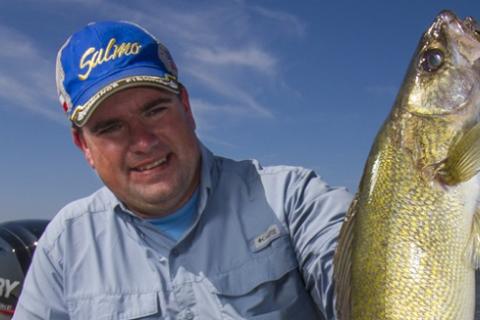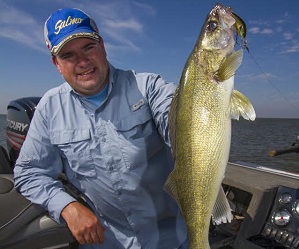
Tips for More Walleye this Season
Fishing can remain frustrating, humiliating and most of all humbling regardless of how much you get to fish or how much you think you have learned. There will always come a time when you feel like you just hit a wall. Anybody who has never been stumped on the water just hasn’t backed the boat down the ramp too many times or they are not being honest. Either way we have probably all pounded a lake from before sunrise to after sunset with our pride seriously tarnished.
never been stumped on the water just hasn’t backed the boat down the ramp too many times or they are not being honest. Either way we have probably all pounded a lake from before sunrise to after sunset with our pride seriously tarnished.
I can’t tell you how many lessons I have had to learn over and over in my life but regardless, here are a few guidelines that just might help you catch a few more walleye this season. Believe me when I tell you that some of this Intel is hard earned. None of you want to know how many tough days of walleye fishing I have had in my life.
Tip One: Understand Water Clarity
One of the secrets to catching walleyes consistently is just avoiding bad situations. Extremely clear water and extremely turbid water are two conditions to avoid when possible.
You can sometimes find the right water by using wind. On really clear bodies of water, wind will give the wind blown area of the lake just enough stain. On the flip side, what we see so often on wind swept prairie dish bowl lakes is that wind can whip up too much turbidity in the water and we end up looking for areas that are out of the wind so that the sediment can settle.
Fishing is usually better in stained water, that is water that has some color and this stained water often gets moved or pushed around the lake with wind or current. There is a difference between stain and turbidity. Fish can still see well in stained water but can’t see well if the water is turbid (cloudy or muddy).
This is why mud lines have a life cycle. Mud lines create an opportunistic window when waves crash up against a bank until a veil of turbid water protrudes from the shoreline. In the early stages of the mud line, the plume of churned up muddy water reaches out and hangs like a veil in the top of the water column and at this stage is typically when mud lines are the most productive. As the wind continues to pound and the veil becomes bigger and sinks down through the water column, the bite will often dissipate.
So often when wind churns up sediment and clouds the water, the day after the big wind can sometimes be the best because as the sediment sinks, the visibility increases yet still offers some stain in the water.
What also happens is that the water will get a green color as it warms up so we often find stained water with the temperature gauge. Colder water is often much more clear and warmer water is typically more stained.
Tip 2: Focus on the Process
So often with walleye fishing, the key to catching fish is to find fish. At times, locations will let you down and specific spots will let you down. Tried and true patterns will sometimes disappoint. What never fails however if you have enough time is an honest and thorough process of elimination.
In order to truly be successful, you have to almost turn off human emotion and start checking off possibilities from the list. The walleyes should be shallow but they are not, next step is eliminating main lake structure in depths from twenty to forty feet as an example. The key is to keep checking off possibilities even if the possibilities don’t feel right at the time. So often, there are things happening in an ecosystem that we don’t have a grasp of until after the fact.
When it comes to finding fish, the least you know going into the day is sometimes better because you can adhere to the process of elimination easier. If you give something a good honest effort and it isn’t happening, turn the switch. It is always amazing how many anglers will cling to a spot or pattern for agonizing amounts of time.
Been guilty of beating a dead horse myself. This is why a clock is an invaluable fishing tool. Use the element of time to force yourself out of ruts and also use the clock to slow you down when you begin to scramble. What can also happen in search mode is not giving any one spot enough time. Commit yourself to hour increments as you begin the process of elimination so that your day has some structure and you can stick to the strategy.
Tip 3: Worry about Efficiency
I honestly believe that most anglers worry about the wrong stuff. They get hung up on matching the hatch or they simply out think the fish. With everything that you do in fishing, focus on becoming as efficient as possible because this can greatly increase your likelihood for success.
Consider this, if you can become twice as efficient, you can basically become twice as successful. Do some real honest self-evaluation and try to do an honest assessment of how much you actually have a lure or hook in front of fish. If you can take steps to become more efficient, you will basically increase your success exponentially. If you can land a higher percent of the fish you hook or hook a higher percentage of bites, your success climbs.
Most people want some secret formula. Some B.S. reasoning that if there is sunshine, you need to use bright colors or if there are perch in the lake, you need to worry about using a perch color. Worry about being in the right place at the right time and when you get an inch, take a mile. You do all of these things right and you can use the wrong color to catch all kinds of fish in the right spot at the right time until the paint is all chipped off.
Tip 4: Chameleons Catch More Fish
We all have our favorite way of doing something. We all have something that gives us confidence. Sooner or later however, there will come a time when you are simply an observer. Somebody else is catching all kinds of fish and all you can do is watch. A little humility can do an angler a lot of good if you let it.
When it is your turn to watch somebody else put on a clinic, embrace the opportunity and let the experience make you a better angler. That means no excuses or over evaluation. Adjust and match, be the chameleon.
Again, don’t get hung up on cosmetics but monitor and break down the big picture, watch the jig stroke, the rate of retrieve, casting angle, visualize what that successful presentation is doing in relation to the structure and fish. Visualize what the lure or presentation looks like. If you are fishing below the boat, look to see what the angle is from the rod tip to the water and match that angle with the angler that is catching fish. Test location versus presentation so that you gather better information. Locational nuances to test might be pushing the boat up or out of the break.
When somebody is catching fish and you are not, the best thing that can happen to you as an angler, is to figure out why. This often means you will have to swallow some pride.
Tip 5: Make Time to Learn
As a guide, it was easy to go right back to the same old well because of the familiarity. Could be as simple as going back to a good spot or sticking with a presentation that had worked well in the past. There are times however when we cling to the past as anglers and that experience that works so well for catching fish can start to work against us.
Spend parts of your day exploring. Make a point to try something different each day. Mix up exploring the unknown with the tried and true. Force yourself to embrace the unknown. Experiment with new lures, new tactics and most of all new locations. Try approaching old locations with a different mindset.
What I have found for myself personally is that learning new things keeps fishing exciting and fresh. I sometimes hear anglers complain that there is nothing new in walleye fishing but it is safe to say that anglers who are learning nothing new are not making an effort.
By forcing yourself out of the rut, you not only expand your knowledge but also increase the amount of satisfaction from fishing.
By Jason Mitchell
- 4832 views

